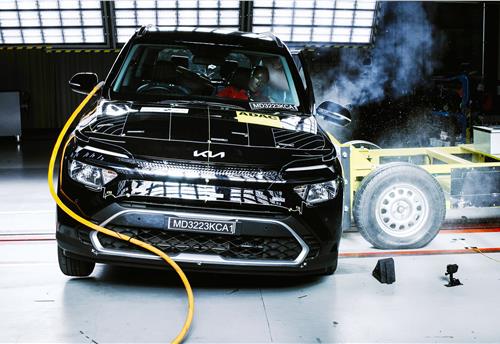India’s shift to e-mobility can save $330bn by 2030, reduce 1 gigaton of CO2: FICCI-Rocky Mountain Institute Report
The latest report, which comes 6 months after the NITI Aayog-RMI report, once again pushes the government’s cause for all-electric mobility in conjunction with a shared and connected mobility system.
India’s transition to a shared, electric and connected mobility system is both a massive challenge as well as huge economic opportunity. The country has the chance to leapfrog the western mobility paradigm of private-vehicle ownership and create a shared, electric and connected mobility system, saving 876 million metric tons of oil equivalent, worth US$330 billion (Rs 20 lakh crore) and 1 giga-tonne of carbon-dioxide emissions by 2030.
This, in essence, is the core message of a FICCI-Rocky Mountain Institute report titled ‘Enabling India’s Transition to Electric Mobility’ released by Union Minister Nitin Gadkari at a conference on smart mobility, arranged by FICCI in New Delhi today. Using a collaborative approach, coordinated action and the strategies and solutions in this report, India can overcome key barriers to EV adoption and potentially become a global leader in electric mobility, states the report.
Estimates indicate that India’s urban population will nearly double in the next decade, to approximately 600 million in 2030 and forecasts suggest that by then India’s urban population will take almost 500 million trips per day. While this rapid growth presents major policy and business challenges for India’s public and private sectors, respectively, it also presents an enormous economic opportunity. Optimising e-mobility use for everyday life with greater thrust on use of public transport, e-vehicles, metro solutions and shared rides as means for mass transit could also prove game-changers in addressing the issue of air pollution in urban areas.
According to the FICCI-Rocky Mountain Institute report, If India is successful in reaching its EV target, the market could be enormous. Even under a shared mobility paradigm, over 46,000,000 vehicles (two-, three-, and four-wheelers) could be sold in 2030. This annual market size would present an opportunity for Indian companies to become leaders in EV technology on a global scale.

Challenge but also a business opportunity
By 2027, four-wheel EV sales may exceed sales of internal combustion engine (ICE) vehicles. After this intersection point, four-wheel EV sales will grow rapidly, with nearly 16 million four-wheel EV sales in 2030. While achieving 100 percent EV sales by 2030 is challenging, doing so would create a major business opportunity for automakers. Realising this goal would have a significant impact on India’s vehicle stock, with a nearly equal split between ICEs and EVs by 2030 in the 4-wheel segment.
Barriers to EV adoption claimed to be falling steeply
One by one, the main barriers to EV adoption — price, selection, range, charging, and consumer awareness — are falling due to steeply falling technology costs, business model innovation, and increasing connectivity. India can accelerate its EV adoption by addressing these key challenges through a whole-systems approach.
The report discusses potential solutions to these challenges across six areas of the passenger mobility sector:
Public Transport: to reduce congestion on roads, the cost of transportation for travelers, transportation energy use, and negative environmental impacts.
Sharing and mobility services: To unlock the competitive and often superior economics of high-mileage EVs through a variety of innovative business models, while creating jobs and enhancing access to India’s critical public transit network; Interoperable transit data, to enable sharing and mobility services, as well as better access, affordability, and multimodal integration;
EV charging infrastructure: To power EVs and to provide valuable grid services, reducing customers’ concerns around range anxiety and enhancing India’s rapidly changing electric grid.
Battery swapping: To reduce the upfront cost of EVs and to complement EV charging infrastructure through a more centralised, less distributed form of charging EV batteries.
Battery manufacturing: To reduce the cost of batteries—currently the most expensive EV component—and to make them in India, thereby accelerating EV adoption, both in India and globally, while creating jobs and avoiding a future in which India replaces costly oil imports with lithium imports.
“The FICCI-RMI report on ‘Enabling the Transition to Electric Mobility in India’ highlights the way forward to accelerate electric mobility in India while addressing the key areas of shared mobility services, interoperable transport data, EV charging infrastructure and manufacturing,” said K Ramchand, chairman, FICCI National Committee on Infrastructure and managing director, IL&FS Transportation Networks.
Amory Lovins, co-founder and chief scientist, Rocky Mountain Institute added, “Recently, global solar PV and battery prices have dropped 80 percent in five years. Signs indicate that the pace of India’s energy transformation could be astonishing: the nation singlehandedly reduced the cost of LEDs by 80 percent in one year, and the government of India has set its sights on an ambitious target of 100 percent electric vehicles by 2030.”
Humungous fuel savings to be had
The new report comes a little over six months after ‘India Leaps Ahead: Transformative Mobility Solution’, a joint report produced by NITI Aayog and Rocky Mountain Institute, was released. At the time, that report said accelerated adoption of electric and shared vehicles could save $60 billion per year in diesel and petrol costs in a single year (2030) and US$ 300 billion cumulatively by 2030. It also states that India could reduce its emissions by as much as 1 gigaton (GT) of carbon emissions cumulatively by 2030. This was based on savings of 156 million tonnes of oil.
While there is little doubt that electrification is the transportation reality of the future, achieving all-electric mobility is deemed an extremely difficult task even in developed markets. Nevertheless, the auto industry in India, both OEMs and suppliers, are making moves, gingerly or otherwise, to plug into a new mobility dynamic.
Also read: All-electric fleet by 2030 ambitious but not fully achievable: JATO LMC
RELATED ARTICLES
Ford to build more EV software capability at Chennai tech hub
Ford Business Solutions India, which currently employs 12,000 personnel set to add 3,000 more; Ford, which is known to b...
ASK Automotive to set up JV with Aisin to sell aftermarket parts for cars
Ask Automotive will have 51% of the equity of the joint venture to be set up with Aisin Asia (Thailand) Company and Aisi...
Kia Carens gets 3-star Global NCAP rating in fresh tests
The Carens MPV, which was tested twice under the new protocol, scored zero stars for adult occupancy in the first test.





 By Autocar Pro News Desk
By Autocar Pro News Desk
 20 Nov 2017
20 Nov 2017
 9477 Views
9477 Views









